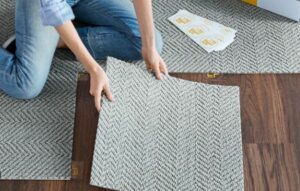How to Clean White Shoes Properly
-
 By
Sophia Grant
By
Sophia Grant
Imagine this – you’re stepping out for a casual walk in the city when suddenly, you notice a stain on your favorite pair of white canvas shoes.
Is it possible to get them white again? What products should you use to clean your fabric shoes?
For the answers, be sure to keep reading. We’ll be going over everything you need to know about how to clean white canvas shoes below!
Table of Contents
ToggleUsing ACTIVE Laundry Detergent to Clean Your White Shoes
ACTIVE Laundry Detergent isn’t just great for clothes, it can also be used to clean your shoes. Here’s how.
Make a Cleaning Paste with the Detergent
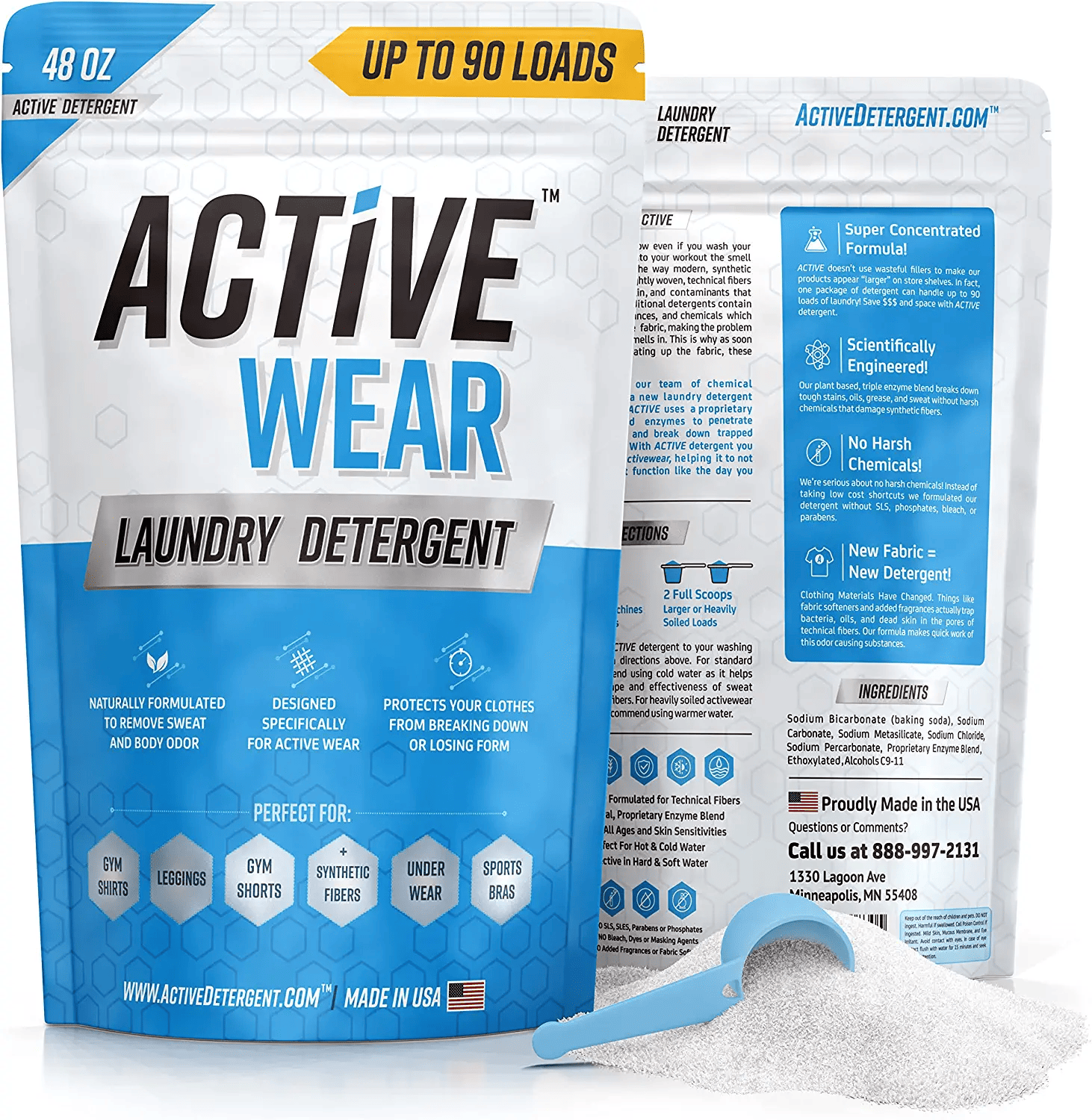 Mix equal parts of warm water with ACTIVE Laundry Detergent in a small bowl until it forms a paste-like consistency.
Mix equal parts of warm water with ACTIVE Laundry Detergent in a small bowl until it forms a paste-like consistency.
Wearing a pair of rubber gloves, carefully apply this mixture onto your white sneakers using a soft cloth or suede brush. Be gentle and remember: vigorous rubbing isn’t necessary here.
Let the paste sit on the fabric for 15-20 minutes before washing it off with lukewarm water. ACTIVE’s powerful yet gentle formula, combined with some elbow grease (and love), will work its magic on those stubborn stains.
If needed, repeat the steps until desired cleanliness is achieved, then allow your shoes to air dry completely in an open space away from direct sunlight.
How to Clean White Shoes Based on Material
White shoes, whether they be made of leather, suede, or canvas fabric, require special attention to remain looking their best.
Cleaning Leather Sneakers
For white leather shoes, a simple wipe-down with a clean cloth can do wonders.
If the dirt stains persist, consider using a quality leather cleaner. It will effectively remove stubborn stains without damaging the delicate fabric of your shoes from Fila or other brands.
Cleaning Suede Shoes
Cleaning suede is trickier because it’s more sensitive than other fabrics. The key here is avoiding harsh chemicals that could damage its texture. Instead, opt for specialized suede cleaners.
Most suede cleaning kits will come with a dry brush that you can use to remove loose dirt before you start scrubbing with the cleaning solution.
How to Clean White Shoes with DIY Methods
Your beloved white sneakers have seen better days, and you’re desperate to get them back to their true white. Fear not. With common household items like baking soda and vinegar, you can make your sneakers clean again.
Using Baking Soda Mixture
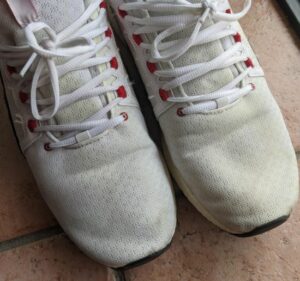 Baking soda is a powerful ally in the fight against dirt stains on your kicks. Mix a small amount of baking soda with two parts white vinegar and one cup of warm water. The white vinegar will combine with the baking soda to create a thick paste that’s perfect for cleaning those stubborn spots.
Baking soda is a powerful ally in the fight against dirt stains on your kicks. Mix a small amount of baking soda with two parts white vinegar and one cup of warm water. The white vinegar will combine with the baking soda to create a thick paste that’s perfect for cleaning those stubborn spots.
Dampen a soft cloth or paper towel in this magic concoction and gently scrub it over the entire shoe. Pay special attention to particularly dirty areas; but remember, be gentle if it’s delicate fabric like suede.
Finally, let your shoes air dry completely before wearing them out into the world again – shiny as new.
How to Clean the White Soles of Your Shoes
Cleaning the Soles with ACTIVE Detergent
In a sink, mix a bit of ACTIVE detergent with some warm water to create a soapy solution.
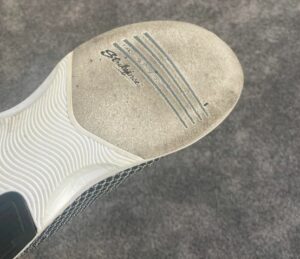 Carefully place your shoes in the sink so that the soles are completely covered by the detergent mixture. Let it sit there for 20 to 30 minutes, longer if the soles are excessively dirty – that will give the enzyme formula time to break down the dirt and gunk.
Carefully place your shoes in the sink so that the soles are completely covered by the detergent mixture. Let it sit there for 20 to 30 minutes, longer if the soles are excessively dirty – that will give the enzyme formula time to break down the dirt and gunk.
Rinse the soles with running water afterward and gently wipe dry with paper towels.
Cleaning the Soles with Baking Soda and Vinegar
Mix two parts white vinegar with one part water to create a paste. Gently rub the mixture onto the sole of the shoes and let it sit for at least 30 minutes.
Rinse off the paste with cool water afterward.
How to Wash White Shoes in the Washing Machine
Some shoes, like white sneakers, may be machine washable. For this method, we recommend using ACTIVE Detergent.
Measure one scoop of the detergent powder pour it directly into the washer drum and run a normal wash cycle.
Tip: It’s best to wash the white shoelaces separately. We recommend taking them out of the shoe and putting them in a mesh laundry bag for thorough cleaning. Wait until they’re completely dry before putting them back in.
Preventing Damage in the Washing Machine
Before tossing your shoes into the washing machine, keep a few things in mind.
Firstly, you want to remove any loose dirt or grime from your sneakers with a dry brush or damp cloth. You don’t want these lingering stains messing up your clean longer plan.
Place each shoe inside a pillowcase or wash bag to protect against the harsh banging during the cycle.
It’s also a good idea to throw in a couple of towels – that’ll help balance the load.
Tips for Keeping Your White Canvas Sneakers Clean
Keeping your white sneakers clean isn’t just about cleaning them when they get dirty; it’s also about preventing dirt and stains from settling in the first place.
Protecting Your White Canvas Sneakers
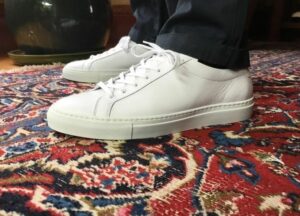 You can keep your shoes clean longer by being selective with where you wear them. Avoid muddy parks or rainy streets to minimize exposure to potential stains and scuff marks.
You can keep your shoes clean longer by being selective with where you wear them. Avoid muddy parks or rainy streets to minimize exposure to potential stains and scuff marks.
You can also apply a protective spray on your clean shoes – it will offer a layer of defense against dirt, acting as a barrier between your precious whites and any grime they might encounter during the day.
Just make sure it’s suitable for the shoe material. For example, some sprays may damage suede shoes.
Another tip is keeping sneaker wipes handy. They’re perfect for quick wipe-downs after a walk, removing surface dust before it gets ground into the fabric.
The key here is regular cleaning: don’t let those scuffs build up. A bit of daily maintenance will help avoid stubborn stains that require more rigorous cleaning methods later on. Maintenance Tips Here.
How to Clean White Sneakers – FAQs
How do you clean dirty white shoes without bleach?
You can use a mix of baking soda and white vinegar to make a paste. Apply it on the shoe and gently scrub with an old toothbrush, then rinse off.
How do you clean white mesh sneakers?
Dip your toothbrush in soapy water and brush lightly over the mesh area. Rinse with warm water and air dry afterwards for best results.
How can I get my white canvas shoes white again?
Create a cleaning solution using dish soap or laundry detergent mixed with warm water. Scrub stains away gently using this mixture paired with a soft bristled brush.
How do you clean white rubber shoes?
To brighten up rubber areas on your kicks, rub them down with a magic eraser or damp cloth soaked in warm soapy water.
Can I use liquid dish soap to wash my white leather shoes?
No, leather is a delicate fabric and should not be washed with liquid dish soap. Consider using a dedicated leather cleaning product instead.
For canvas shoes, however, you can use a few drops of liquid dish soap to remove mild stains.
Can I use a bleach solution on my white sneakers?
Depending on the fabric, you may be able to clean your shoes with a heavily diluted bleach solution. Keep in mind, however, that you don’t want to use too much bleach as that can damage the fabric.
Can I clean my shoes with white toothpaste?
White toothpaste may help get rid of mild staining. However, it likely won’t be enough if you want your shoes to be sparkly white again.
Now you’re equipped with the knowledge to clean your white sneakers. As you can see, there are several products that you can use for your bright white shoes, the most effective being ACTIVE Detergent.
Not only will it remove dirt and stains but it’ll eliminate odors as well. That way, you won’t have to worry about having smelly sneakers!
15% Off Amazon Coupon
×Click To Reveal The 15% Off Coupon Code For Your Entire ACTIVE Purchase At Amazon.com
Note: This promotional offer is only guaranteed through the end of the day.




